|
Basilicata and Puglia
24 September 2013
Leaving Sicilia – we really like Sicilia, but
the problems there are enormous – the economy, the corruption and added to that,
the problems with the clandestini (illegal immigrants) as problems in Africa and
the Middle East increase.
The drive to Messina was uneventful and we only
took one wrong turn (amazing) getting to the ferry. Upon arriving at the
mainland, we had amazing good luck getting to our accommodations for the night –
a beautiful olive farm in Calabria. I think this once may have been a feudal
farm and the building in which we are staying was part of the housing for the
workers. That being said, it has been renovated to a very high standard. We had
dinner in the restaurant on the grounds.
We have been struck by the number of wind mill
and solar farms in Italy – well, there is a reason – they are a money laundering
scheme for the N’Drangheta and Cosa Nostra. Turns out they get handsome
subsidies from the EU for building the farms even if the landowners don’t want
them – they resort to their usual extortion to force the landowners into giving
up their property. What a sad tale.
Our lodging was absolutely beautiful – an olive
farm with olive oil production. The grounds were immaculate and there was a very
large swimming pool (too cold to swim). Our room was nicely appointed. We had a
pleasant meal in the hotel restaurant. However….about
midnight there was a large party
that was in the ‘other’ restaurant – and it really got swinging. Tom leaped out
of bed, went to the balcony and started yelling ‘You morons, turn that music
down.” It didn’t do any good, so he got dressed and stormed out of the room,
heading to where the ‘DJ’ had his set up. I didn’t witness the scene, but Tom
told me that the DJ looked like he thought Tom was going to throw him and his
equipment in the pool. Our waiter from dinner came out and tried to mollify Tom,
offering him different accommodations, but it was late and Tom declined. The
music was turned down.
 This barrel was obviously just for display, but we wondered if the ones they use
are this large.
This barrel was obviously just for display, but we wondered if the ones they use
are this large.
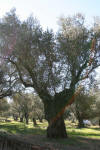

 The olive trees are beautiful but we would not want one in our yard. What a
mess!
The olive trees are beautiful but we would not want one in our yard. What a
mess!
25 September 2013
I guess Tom’s scene at the pool was well noted
as we weren’t charged for the room, only the dinner.
We drove out to Matera, which is in Basilicata.
This is one of the most interesting towns we’ve ever seen – the original
inhabitants settled here by building homes in caves. Eventually they added to
their homes with exterior structures build over the caves.
We had a very nice B & B in the heart of the
‘old town’. Ah, but it would be so much better to be a goat in this town, for it
is straight up and down with lots of steps.
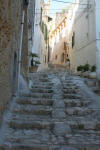
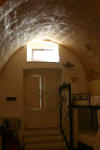 The stairs and inside our B&B
The stairs and inside our B&B
We walked around a bit after we checked in,
found the Tourist Office and booked a walking tour for the next day, and settled
on a restaurant for dinner.
Although getting to and from our B & B took a
lot of hill climbing, it was one of the most comfortable lodgings we’ve had so
far on this trip.
We had dinner in the old town – during dinner
the music was “Pink Martini” – imagine coming nearly halfway around the world to
end up listening to music from Portland.
26 September 2013
We had breakfast on the terrace overlooking
Matera – very beautiful. Then we had our walking tour with Luigi. This area has
been inhabited for 6,000 years. As recently as 1953 there were people living in
the caves, but the Italian government moved them out of the caves and provided
them with modern housing. Our tour included a visit to one of the caves, which
was furnished with original furnishings donated by the family that once lived
there. It was crowded – there were 11 people, plus the mule, chickens and pig.


 The scenery is spectacular.
The scenery is spectacular.

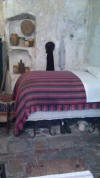
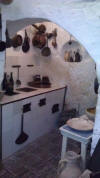 This would have been very tight quarters.
This would have been very tight quarters.
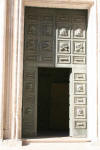
 This church with the bones was really interesting.
This church with the bones was really interesting.

 More caves and a cityscape.
More caves and a cityscape.
One of the things that made habitation possible
was a series of cisterns that collected rainwater.
There were four churches built into the caves,
but in the 1700s they were deconsecrated and turned into wine storage areas. The
temperature was perfect for the job.
 That's a whole lot of rocks.
That's a whole lot of rocks.
Our drive to Cisternino was reasonably
uneventful – a few wrong turns. We checked into our trulli – the owner wasn’t
home, but her mother, who speaks no English, showed us around. Well, we wanted
to be able to speak Italian.

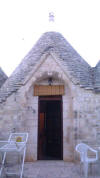
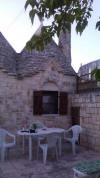 Our trulli
Our trulli
We drove to Martina Franca for groceries – turns
out that the shops in Cisternino are closed Thursday afternoons. We remembered
the store from 2008 when we stayed in Martina Franca. The produce is pathetic,
but the salumi, cheese and chicken were quite good. Here in Italy they trim your
meat for you, then weigh it, so you don’t end up buying the waste product.
The truli is quite nice – a largish living area,
nice bedroom, well equipped kitchen and a bath with a shower. There are screens
on the windows (just as there were in the B & B where we stayed last night –
amazing additions).
27 September 2013
We had a quiet day today, just walking around
Cisternino a bit and learning the lay of the land. We found a walking street
where there are several shops, including a nice pasticieria and a salumeria, not
far from that an enoteca. The ‘supermarket’ in Cisternino is pathetic. We also
found a fruttivendolo and a place that sells fresh pasta.
We tried to find the spa at Torre Canne, but we
couldn’t figure out how to get into the spa facilities – it appeared to be a
medical center, not a spa. Oh well!
28 September 2013
Today we drove to Locorotondo – what a beautiful
little town – one of the prettiest we’ve ever seen here in
Italy. The centro storico is quiet, clean and filled with flowers from the
balconies – there is a contest to determine who has the prettiest flowers in the
old center.

 Locorotondo
Locorotondo
We had a great massage in Cisternino.
29 September 2013
We had read about the ‘Greek towns’ on various
websites, so we decided to drive to them – they are in the heel of the ‘boot’.
Well, it was a severe disappointment. Along the way we saw terrible litter –
worse than any we’ve seen in Puglia.
I think that the ‘Greek towns’ have died out and
are becoming plain old ordinary ‘Italian towns.’
30 September 2013
Shopping day – what a chore! I can see why
Italy’s economy is such a mess. It takes hours to do the shopping and you have
to fit it into the shops’ schedules – open around
8:30, close at 1:30, open again at
5:00 and close at 7:00. What a
waste of time. So, we hit the salumeria, the fruttivendolo, the macelleria, the
enoteca. We also went to the pathetic excuse for a supermarket – crowded and
insufficient. Makes you long for a Carrefour.
After putting the supplies away in our trulli,
we went to the World Heritage Site, Alberobello. No one know the story behind
the trulli, although there is some thought that one of the local lords was
behind it – they are easily built and easily dismantled. If the tax man was
expected, the people dismantled them – voila’ lower taxes. Trust an Italian to
figure out a way around paying taxes. The trulli are charming and there are 1400
of them in Alberobello.

 Alberobello
Alberobello
We had an email from the tour guide with whom we
were booking a tour, so we met him, his wife and a friend in the pedestrian area
of Cisternino for light refreshments. We’ve booked a tour for tomorrow.
1 October 2013
Tour day – and a long one – we were picked up at
our trulli at 9:30 By Giovani Fasano, the guide, and David Buffalino, the
driver. We drove to Lecce, where we had a break, then onto Masseria (large
estate) L’Astore where wine and olive oil is produced. We toured the underground
olive press area (imagine living underground for 6 months of the year – with
olives pits, donkeys and unwashed men). After we enjoyed light refreshments,
including a wonderful sun-dried tomato concoction – cherry tomatoes, capers,
olive oil.

 The olive press area
The olive press area
From there to the town of Gallipoli, which is
not the ‘soft underbelly of Europe' of WWI fame. Rather it is a charming town on
the instep of Italy. A beautiful beach, nice centro storico and a very nice
lunch at a restaurant that specializes in seafood (makes sense). We had four or
five different antipasti (all seafood based) and then a nice pasta dish
(spaghetti with fresh tomato and pesto and a little bit of fish).
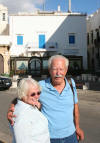


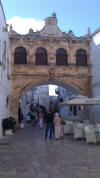 In
Gallipoli
In
Gallipoli
From there to Lecce, which is such a beautiful
city – we walked around for a couple of hours. It has a fabulous cathedral,
beautiful buildings in the centro storico, and is very lively, being a
university town. We loved it.
Tom at long last found the bag he has been
looking for since we got here, so, even though it was rather expensive, he
splurged.
In actuality, we are doing very well on our
budget for a couple of reasons – we over-budgeted and food is cheaper here than
we expected.
2 October 2013
We drove to a town, Grottoglie, which is the
center of ceramic production. Well, we couldn’t find the museum, couldn’t find
the centro storico and the town is ugly! So we left, drove to Ostuni.
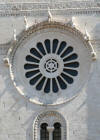 In
Ostuni
In
Ostuni
In search of lunch, we drove around and found a
parking spot then walked to a little restaurant and were very surprised to run
into David, our driver from yesterday. After we had lunch, David walked with us
to the centro storico. Tom and I walked up the hill to the cathedral (beautiful)
and through some of the old area of town. Ostuni is quite lovely. The patron
saint (can’t remember his name) is credited with saving Ostuni and Lecce from
the plague. Turns out that he ordered Ostuni to be painted with a lime based
paint (hence the name “white city”) and that had the effect of killing off the
pests.
3 October 2013
We booked a ‘rickshaw’ tour in Bari. We had no
idea what to expect, except that we knew that Bari had been a very important
site in WWII – in fact, an attack by the Germans is referred to as ‘Little Pearl
Harbor”.

Our stupid GPS had us going on tiny little roads that eventually led to dead ends, so
we were late making our appointment, but once we got there, we found the city to
be enchanting. The old town is beautiful and lively – the homes are three
stories, with the kitchen on the ground floor and the sleeping quarters on the
other floors – there is no ‘living room’ so people tend to live in the streets.
They actually take their little braziers into the streets to cook some of their
meals. The streets in the centro storico are narrow and meet at odd angles. The
folks who live there have front doors, but during the day they don’t close them
when they are home – they may only have a curtain over the door.
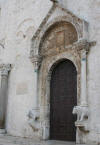


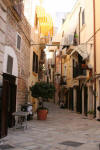 In
Bari
In
Bari
The women make orecchiette (pasta shaped like
ears, hence the name ‘little ears’) and put them on racks to dry outside their
homes.

One of the most interesting sites in Bari is the
Basilica. It is the resting place for the bones of St. Nicolas. The ground floor
is a Catholic church. The crypt is an Orthodox church. While we were there,
there was an Orthodox Mass in the crypt. St. Nicholas is a very important church
for the Russian Orthodox and Bari is a pilgrimage site for them.
 People attending te Orthodox Mass
People attending te Orthodox Mass
We had the best gelato ever at a place called
the Antica Gelateria Gentile (Gentile is the family name of the owners). It had
a thicker consistency than a milk shake, but thinner than a gelato. It was so
good that after lunch we went back for seconds. Tom says that when we go back to
Bari he wants to stay within walking distance of the Gelateria.
 Near the gelateria
Near the gelateria
Lunch was….confusing. We went into an Osteria.
The owner directed us to a table, recited the menu and then we had to try to
remember what he had said and place our order. The lunch had four plates of
anit-pasti – prosciutto, cheese, olives, tomatoes, cucumber, potatoes (cold,
with olive oil). Then the primo piatto – pasta with fresh tomato sauce. Tom gave
up at that point. I had a bit of fresh seafood – gamberi and calamari – it was
beautifully cooked. Then a piece of melon. Optional was a sweet, wine and
coffee. There was no way we could eat all of that. Especially since we had to go
back to the gelateria!
Bari is beautiful and interesting – not a gritty
port town at all. We want to go back. |